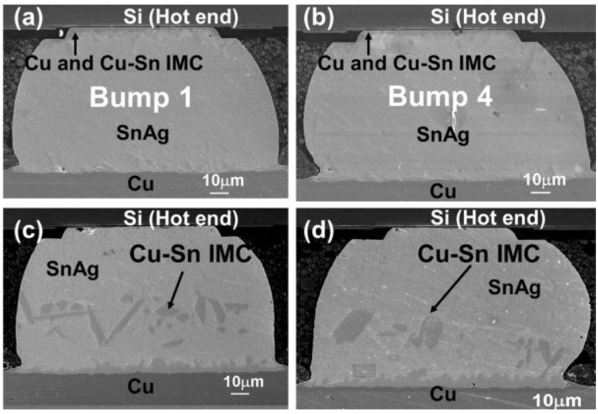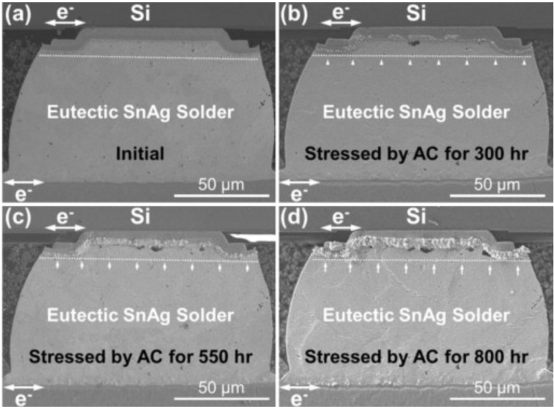Thermomigration of Solder Joints _Shenzhen Fitech

Thermomigration of Solder Joints _Shenzhen Fitech
One of the causes of thermomigration is the inconsistent internal temperature of the alloy. When heat treating a uniform binary alloy, due to the temperature difference between one end and the other end of the alloy, metal atoms will migrate, and the alloy will become uneven. Not only does thermal conduction cause thermomigration, but atomic diffusion within the alloy is also the cause of thermomigration. There are still some uses of binary alloy solder paste in semiconductor applications, such as SnAg, SnCu, SnPb solder paste, etc. The alloy elements such as Ag and Cu in these lead-free solder pastes diffuse in the gaps of Sn. Rapid interstitial diffusion will enhance the flux of thermomigration.
Thermomigration of Cu atoms
The interstitial diffusion of Cu in the Sn matrix is fast, especially driven by large thermal gradients. Figures 1 (a) and (b) show SnAg solder joints before electromigration and thermomigration tests. It can be found that Cu6Sn5 bonded well with Cu UBM. Bumps 1 and 4 were heated to 150 ℃ without applying electrical current, while two selected reference bumps were applied with a current of 0.55A. It was found that the four bumps experienced almost the same joule heat due to the excellent thermal conductivity of the silicon die. After applying current stress for 76 hours, it was observed that Cu6Sn5 IMC in the bump migrated to the substrate end after thermomigration. Figures 1 (c) and (d) show the microstructure changes of bumps 1 and 4 after thermomigration testing, respectively. It can be observed that the Cu UBM on the Si chip has almost completely disappeared.

Figure 1. Thermomigration of Cu in Cu/SnAg/Ni solder joints. (a) (b) before thermomigration test; (c) (d) after thermomigration test.
The low solubility of Ni in solder paste also slows down the occurrence of Ni atom thermal migration. Researchers found that at 250°C, the solubility of Ni in a lead-free solder is only 0.28wt%, which is much smaller than the solubility of Cu. Therefore, depositing Ni UBM on chips can usually serve as a barrier to inhibit Cu migration.
Thermomigration of Sn atoms
By studying eutectic SnAg solder joints, it can be found that the internal structure of the solder joints is uniform before applying electrical current. When applying an alternative current of 0.57A, a thermal gradient of 2829 ℃/cm was generated by the joule heat inside the solder joint. After applying electrical stress for 300 hours, pure Sn nodules began to appear on the side of the Si die (hot end). As the stress time increases to 550h, the volume of Sn on one side of the Si core begins to increase. When the stress time reaches 800h, a large amount of Sn can be clearly observed. From the experiment, it can be seen that Sn in the solder began to migrate due to electrical stress, and Sn migrated from the solder joint to the side of the Si die.

Figure 2. Thermomigration with a thermal gradient of 2829 ℃/cm. (a) 0h; (b) 300h; (c) 550h; (d) 800h.
Fitech's solder paste
Fitech has years of experience in solder paste development and sales and can provide customers with various customized solder paste products, including SAC305 and SnBi57.6Ag0.4, etc. In addition, Fitech can provide customers with semiconductor soldering material solutions, such as optimizing reflow curves and soldering processes. Welcome to contact us for cooperation.
Reference
Chen, C., Hsiao, H.Y., Chang, Y.W., Ouyang, F. & Tu, K.N. (2012). Thermomigration in solder joints. Materials Science and Engineering: R: Reports, vol.73.

















 Back to list
Back to list



